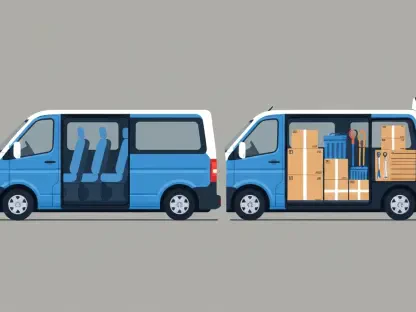The rapid evolution of industrial operations is marked by the integration of advanced technologies aimed at optimizing efficiency and productivity. One such transformative technology is the Real-Time Location System (RTLS), often compared to a GPS designed explicitly for industrial applications. RTLS stands out by offering not just positional data but also real-time, actionable insights that significantly improve decision-making processes. Unlike traditional tracking systems that provide limited, static information, RTLS delivers continuous feedback, guiding employees through complex processes with greater accuracy and efficiency. This capability is particularly valuable in precision-intensive environments like manufacturing and logistics, where minor errors can result in significant losses.RTLS is not merely a tool for indoor navigation; its comprehensive data visualization capabilities transform raw data into clear, interpretable formats. Visualization tools integrated with RTLS help identify workflow bottlenecks, optimize asset utilization, and ensure route efficiency. These insights empower businesses to make informed decisions that lead to substantial cost reductions and productivity gains. By leveraging RTLS, industries can not only track assets’ positions but also analyze their movements and interactions in real-time, thus driving efficiency and operational excellence.
The Role of RTLS in Industrial Operations
RTLS serves as a critical tool in tracking the position and movement of assets within industrial settings, providing real-time data that enhances decision-making processes and operational workflows. Unlike traditional tracking systems that offer a static, retrospective view, RTLS delivers dynamic, real-time feedback that can guide employees efficiently through complex processes. For instance, forklifts equipped with RTLS can display the next required action instantly, reducing human errors and streamlining operations. This capability is especially invaluable in environments where precision and efficiency are paramount; it ensures that operational tasks are executed correctly and timely, optimizing productivity.The true strength of RTLS lies in its ability to visualize collected data, thus offering industries a deeper understanding of their workflows. Such visualizations contribute to identifying bottlenecks, optimizing routes, and ensuring that assets are utilized to their fullest potential. Consequently, businesses can see a significant reduction in operational costs and an improvement in overall productivity. By converting location data into visual insights, RTLS enables organizations to focus on continuous improvement, making iterative adjustments that boost efficiency and performance across the board.
Integration of Data Visualization Tools
One of the most notable advancements in RTLS technology is the integration of data visualization tools that convert raw data into actionable insights, making it easier for employees to interpret and respond to information in real-time. Digital displays on equipment and assets provide up-to-date information, which is essential for maintaining efficient workflows and reducing downtime. For instance, in a warehouse setting, digital tags on shipping containers can dynamically update to reflect the current status and destination of goods. This real-time feedback aids employees in making informed decisions, thereby reducing the likelihood of errors and delays. Furthermore, these visualization tools are highly customizable to meet the specific demands of different industries, offering tailored solutions that enhance operational efficiency.The shift towards using digital displays instead of traditional paper tags also brings considerable sustainability benefits. By eliminating the need for paper and frequent manual updates, companies can significantly reduce their environmental footprint. This transition supports greener practices and aligns with broader industry trends toward digitization and smart data management. The ability to update digital displays dynamically ensures that staff always have the most accurate information, further optimizing workflows and minimizing time and resource wastage. Overall, the integration of advanced data visualization tools with RTLS plays a pivotal role in shaping more efficient and eco-friendly industrial practices.
Real-Time Feedback and Workflow Optimization
Real-time feedback is one of the core advantages of RTLS systems, allowing employees to execute tasks with greater accuracy and efficiency. This immediate feedback loop enhances productivity by providing workers with the exact information they need at the precise moment they need it. For instance, if an error is detected in the routing of a product, RTLS can instantly relay corrective instructions to the appropriate personnel, thereby preventing costly mistakes. In manufacturing environments, this capability is particularly beneficial. Equipment can be continuously monitored, enabling proactive maintenance rather than reactive responses, thus reducing downtime and extending the lifespan of machinery.Real-time feedback also significantly aids in inventory management by providing precise, up-to-date information about stock levels and production stages. By optimizing workflows through real-time data and feedback, companies can achieve higher levels of efficiency, minimizing waste and maximizing resource utilization. This leads to more streamlined operations, where every aspect of the process is closely monitored and continuously improved. As a result, businesses can maintain optimal operational standards, ensuring that each component of the workflow is performing at its best. The integration of real-time feedback mechanisms within RTLS frameworks thus fosters an environment of continuous improvement and operational excellence.
Enhanced Inventory Management
Inventory management is a cornerstone of industrial operations where RTLS, combined with digital displays, offers substantial improvements. Accurate tracking of inventory throughout the production process prevents overstocking and reduces wastage, contributing to more efficient resource utilization. Digital tags provide real-time updates about the status and location of inventory, allowing for immediate adjustments as necessary. For example, an electronic tag on raw materials can indicate low stock levels, prompting timely reorders and thus avoiding production delays. Similarly, finished goods can be tracked until they reach their final destination, ensuring that deliveries are prompt and accurate. This level of precision in inventory management can significantly reduce holding costs and boost customer satisfaction.Moreover, the insights gleaned from RTLS data visualization can help identify patterns and trends in inventory usage, enabling better forecasting and strategic planning. This proactive approach to inventory management ensures that companies can swiftly respond to changes in demand and maintain optimal stock levels at all times. By integrating real-time data with strategic planning, businesses can better align their inventory levels with market conditions, reducing excess stock and minimizing shortages. This not only improves operational efficiency but also enhances a company’s ability to meet customer needs, ultimately driving better business outcomes and higher levels of customer satisfaction.
Sustainability and Efficiency Gains
The adoption of RTLS and advanced data visualization tools plays a significant role in promoting sustainability within industrial environments. By transitioning from paper tags to digital displays, companies can reduce their reliance on paper, thus decreasing waste and supporting eco-friendly practices. This shift benefits the environment and boosts operational efficiency by cutting down the time and effort required for manual updates. Digital displays offer a dynamic, adaptable solution that can be easily modified based on real-time data, leading to more accurate information dissemination and reducing the likelihood of errors. Furthermore, the reduction in paper usage aligns with broader sustainability goals, reinforcing a company’s commitment to environmentally responsible practices.Efficiency gains from RTLS implementation also translate into financial benefits. By optimizing workflows, reducing errors, and improving resource management, companies can lower their operational costs and increase profitability. These advantages make the investment in RTLS and advanced data visualization tools a wise choice for forward-thinking industrial organizations. As industries continue to face increasing pressure to adopt sustainable practices, the dual benefits of efficiency and eco-friendliness offered by RTLS become even more compelling. This convergence of operational efficiency and sustainability helps businesses stay competitive and responsible in a rapidly evolving industrial landscape.
Challenges of RTLS Implementation
Despite the numerous benefits, the implementation of RTLS systems comes with its own set of challenges that organizations must be prepared to address. One of the most significant hurdles is the high initial cost associated with technology and facility upgrades necessary for digitization and compliance with Industry 4.0 standards. Modernizing facilities to support RTLS involves substantial capital expenditure and requires careful planning to manage costs effectively. Another challenge lies in the management of large volumes of data generated by RTLS. Organizations must develop robust data analysis frameworks to handle and leverage this data efficiently, ensuring that it translates into actionable insights that improve decision-making processes.Employee resistance is another critical challenge when introducing new technologies like RTLS. The fear of job displacement and undervaluation of expertise can lead to hesitance and pushback from staff, hampering the smooth integration of the system. To mitigate this, organizations must effectively communicate the benefits of RTLS, emphasizing that the technology aims to enhance employee efficiency and streamline workflows rather than replace the workforce. Comprehensive training programs and continuous support can also help employees adapt to and embrace the new technology, ensuring a smoother transition and maximizing the benefits of RTLS implementation.
Moving Forward with RTLS
The rapid evolution of industrial operations is marked by the integration of advanced technologies aimed at optimizing efficiency and productivity. One such transformative technology is the Real-Time Location System (RTLS), akin to a specialized GPS for industrial settings. Unlike traditional tracking systems that offer limited, static data, RTLS provides continuous, real-time feedback, enhancing decision-making processes. This technology is invaluable in precision environments like manufacturing and logistics, where minor errors can lead to significant losses.RTLS is not just a tool for indoor navigation; its robust data visualization capabilities transform raw data into clear, actionable insights. These visualization tools help identify workflow bottlenecks, optimize asset utilization, and ensure route efficiency. Businesses can leverage these insights to make informed decisions, leading to substantial cost reductions and productivity gains. By utilizing RTLS, industries can track not only the positions of assets but also analyze their movements and interactions in real-time, driving efficiency and operational excellence. This enables a more dynamic, responsive approach to industrial management.









